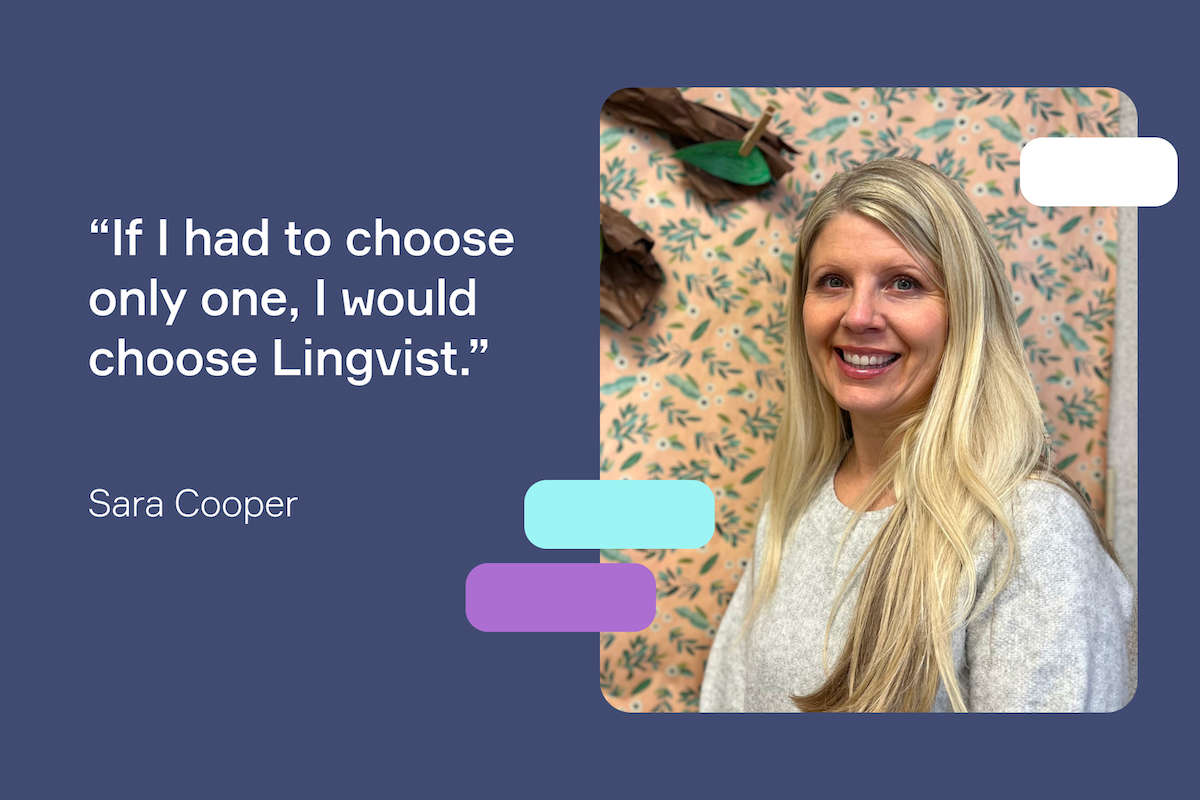Sara Cooper has been teaching language for the past 29 years. She’s from the generation of teachers that preceded the use of technology in the classroom – when all they had to work with was a textbook and a list of words for their students to memorize. However, she has embraced the use of digital devices and mobile apps to help her students improve their experience while learning a new language, and she’s done so successfully.
Currently, Sara works as a French language teacher at Desert Ridge High School in the Gilbert Public School District in Mesa, Arizona, United States. She has been using Lingvist to complement her French classes since 2018 and says that her students are “learning tons of vocabulary very quickly.”
Keep reading to learn more about her positive experience with Lingvist and how it has changed her teaching game and benefited her students.
Introducing technology and Lingvist to the classroom
It was 2017 when the school district first introduced the use of Chromebooks at Desert Ridge High School. Sara began exploring the use of digital tools and language content from YouTube videos, and her students could now watch other people speaking French in different parts of the world.
“The textbooks were just these little cartoon characters that made it look as though this is what everyone in France looked like, and even though I tried to explain that it’s very diverse in France, now they can actually see that,” Sara explains.
But it wasn’t until one of her older students, Ryan, a language enthusiast and polyglot himself, introduced her to a frequency list and eventually to Lingvist, that Sara decided to change everything in her classroom.

The frequency list – “Why are you teaching mango?”
“Why are you teaching mango? That’s not a very important word,” Ryan asked Sara one day. He told her about how polyglots learn languages and introduced her to the concept of frequency: a list of the most common words and how frequently they appear in everyday language. A frequency list can help language learners identify important words to learn and forms an important basis for Lingvist.
“When we were using the textbook, you just had a list of vocabulary, and that is all that students had to go by. Unless they would look up extra words in a dictionary, that was really it. So now, they’ll throw a new word at me every day, and I’ll say, ‘Where did you get that? Lingvist?’”
After a few weeks of introducing Lingvist to her classroom, she saw a lot of progress. The most surprising fact was that it was happening faster than with traditional methods alone.
“The textbook is very slow compared to what we do now, and it’s very limited in what you teach them. Now, with technology, especially Lingvist, it goes so much faster. I feel so much more successful, more progress than with the little bit of vocabulary they got from the textbook. So I would say technology has been the big difference.”
Benefits for all
In the first ten minutes of class, Sara’s students sit in silence with their Chromebooks open while completing their daily Lingvist session. They are assigned fifty minutes of Lingvist every week, which is divided into ten minutes a day, five days a week. This vocabulary practice also comprises part of their grade, so Lingvist is now a part of the daily routine in Sara’s French class.
1. Quiet time while learning
“It’s amazing for my classroom, because they come in – it’s high school, they’re wild, they’re chatty, they’re talking to their friends – and they come in, sit down to start doing Lingvist, and the bell rings and it’s just quiet in my room for 10 minutes.”
While her students are learning new vocabulary and getting their brains into “French mode,” she has the opportunity to focus on other important things. “But it also provides ‘me time’ to take attendance, talk to a kid that was absent yesterday, or do all of those managerial things you have to do in a classroom that you usually don’t have time for when you’re teaching,” Sara explains.
2. It’s easy to use
“This product is already ready to go: you just have to create a classroom, get the kids to sign up, and then it’s pretty magical,” says Sara.
In the Classroom view, teachers can easily check their students’ data, including how many minutes they have done and how many words they have encountered. They can also choose to assign specific vocabulary decks or create their own by uploading a list of words.
“The nice thing is that Lingvist can fit into whichever system you are using. There is really nothing extra that you have to do.”
3. Improved reading
In her years as a language teacher before introducing Lingvist, Sara had experienced some resistance from her students toward reading assignments. The textbooks, as she mentioned, only provide teachers with a limited list of vocabulary based on specific themes, like food or family, not enough of the important words that they need to know to be able to understand a text.
“How do you teach them ‘but,’ ‘and,’ or ‘for’ and have that make sense for them?” Sara asks.
“You really have to know the little conjunctions, those little words that help get you through, and so they would get pretty frustrated with reading. Now I give them reading and they just tell me it’s so easy.”

4. Achieving new goals and passing tests
Now, for the past couple of years, Sara has encouraged her French level 3 students to take the AAPPL test (Assessment of Performance toward Proficiency in Languages) at the end of the course.
Even though this isn’t mandatory in American schools to be able to graduate, if a student takes the test and achieves an intermediate level – B2 in the Common European Framework of Reference (CEFR) – it gives them a so-called “Seal of Biliteracy” on their high school diploma.
“The first year we did it, a couple of years ago, I had three girls achieve that. One of them was not just intermediate; she scored advanced. And I cannot credit myself with this – it’s because she did so much Lingvist. So we would’ve never been able to do that if we had been using the textbook. There is just no way,” Sara says.
5. Helps with engagement
Since introducing Lingvist to her students, Sara has never encountered any resistance from them about using an additional tool to help them improve their French vocabulary. “They might fight me on other things, but they don’t fight me on Lingvist, because they understand how good it is for them and how it really does work. They get that.”
Every year, when there’s a new group of students in Sara’s French level 1 class, after a couple of weeks of learning the French alphabet, numbers, and other basic topics, she gives them a presentation to help her students understand how Lingvist works.
The presentation meticulously explains what Lingvist is about and how they are expected to use it. It also includes information about the frequency list, Lingvist algorithm, and spaced repetition.
Students can also see their own progress by looking at their data in the app: how many words they have encountered, how many they have to study, etc. “That’s what’s really cool for teenagers – they can see the number of words that they’ve been exposed to. And then I have to teach them about the algorithm and how it’s best to do the same amount every day, so that your repeat stack doesn’t add up,” Sara explains.
Once the students get connected with Lingvist, the progress starts happening fast. Seeing the number of words they learn motivates them to keep going, especially when they talk to their friends and compare how many words others have learned. It gives them an extra boost and keeps them engaged with the course.
“I love the day 1 of Lingvist, because it’s never ten minutes on that day: it has to go a little longer, because they’re not ready to close it up and move on. The first time we try it, they want to do it as much as possible.”

Limiting the use of digital devices in the classroom
Sara strongly opposes the overuse of digital gadgets and the internet, especially for kids and teenagers. “Kids don’t need their faces in screens all the time,” she says. So at the front of her desk, there’s a pouch where all the students must leave their phones before the class starts to avoid any possible distractions. They grab a pair of headphones and their Chromebook, and head toward their seats to begin their ten minutes of Lingvist. “On the Chromebook they stay more focused,” she adds.
According to Sara, students need to interact in class. She believes teachers must use a variety of methods besides technology or just textbooks to keep the kids engaged; they shouldn’t only stare at screens.
“I have limited how many apps I use when it comes to my classroom. After they’re done with their ten minutes of Lingvist, I say, ‘Fermez vos ordinateurs’ [‘Close your computers’ in French], we put them away, and then we’ll do other activities in class.”
She then adds, “But Lingvist would be number one. If I had to choose only one app, I would choose Lingvist.”
If you’d like to try Lingvist as an additional tool for your language course or in your organization, you can learn more about Lingvist for Business here.

Try Lingvist in your classroom
Contact us: partners@lingvist.io




